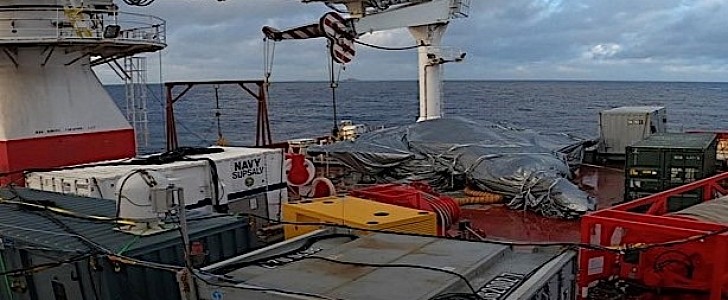More than a month ago, on January 24, the U.S. Navy lost one of its F-35C Lightning IIs somewhere in the South China Sea, during what the military described “routine flight operations.” A race to recover the wreckage ensued, which ended this week with the total recovery of the airplane.
The F-35 crashed as it came in to land on the deck of the USS Carl Vinson aircraft carrier, and a leaked video of the incident showed the plane hit the landing area, begging to spin, and doing that for the length of the deck, until it fell off of it and into the sea. Seven people, including pilot, were injured during the incident.
The Navy began immediate recovery efforts, using the resources of the 7th Fleet’s Task Force (CTF) 75 and Naval Sea Systems Command (NAVSEA). On March 2, what’s left of the plane was lifted out of the water, and will now be shipped to “a nearby military installation to aid in the ongoing investigation and evaluated for potential transport to the United States.”
For the recovery efforts, specialized teams used diving support construction vessel (DSCV) Picasso to get to the scene. Once there, an underwater remotely operated vehicle (ROV) called CURV-21 was used to locate and tie stuff to the wreckage.
CURV had specialized rigging and lift lines attached to it, and once the F-35 was found, 12,400 feet (over 3.7 km, or 2.3 miles) below the surface, these lines were transferred onto the plane. From there, a crane fitted on the Picasso took over and slowly pulled the airplane out of the water.
“The task force’s expertise in rapid, scalable command, control, and communications, agile logistics, organic security, and explosive ordnance disposal was the most flexible choice for the fleet commander to respond in a timely manner,” said in a statement CTF 75 Commodore, Capt. Gareth Healy.
“Ultimately, this deliberate approach resulted in the correct capabilities conducting recovery operations within 37 days of the incident. Given the unique challenges of this problem and the unique technical capabilities that NAVSEA delivered, this was an aggressive and achievable timeline.”
The Navy began immediate recovery efforts, using the resources of the 7th Fleet’s Task Force (CTF) 75 and Naval Sea Systems Command (NAVSEA). On March 2, what’s left of the plane was lifted out of the water, and will now be shipped to “a nearby military installation to aid in the ongoing investigation and evaluated for potential transport to the United States.”
For the recovery efforts, specialized teams used diving support construction vessel (DSCV) Picasso to get to the scene. Once there, an underwater remotely operated vehicle (ROV) called CURV-21 was used to locate and tie stuff to the wreckage.
CURV had specialized rigging and lift lines attached to it, and once the F-35 was found, 12,400 feet (over 3.7 km, or 2.3 miles) below the surface, these lines were transferred onto the plane. From there, a crane fitted on the Picasso took over and slowly pulled the airplane out of the water.
“The task force’s expertise in rapid, scalable command, control, and communications, agile logistics, organic security, and explosive ordnance disposal was the most flexible choice for the fleet commander to respond in a timely manner,” said in a statement CTF 75 Commodore, Capt. Gareth Healy.
“Ultimately, this deliberate approach resulted in the correct capabilities conducting recovery operations within 37 days of the incident. Given the unique challenges of this problem and the unique technical capabilities that NAVSEA delivered, this was an aggressive and achievable timeline.”






